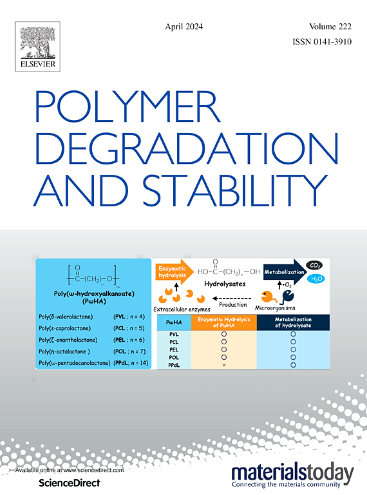Flammability degradation behavior and ageing mechanism of flame-retardant cable sheath under different ageing conditions
IF 6.3
2区 化学
Q1 POLYMER SCIENCE
引用次数: 0
Abstract
The durability of fire-resistant performance is a great challenge for long-life wire and cable sheath materials. The commonly used flame-retardant cable sheath materials were aged by thermal, salt spray and hygrothermal accelerated methods. The effects of different environmental factors on the fire protection performance of cable sheath materials were investigated by cone calorimeter, limiting oxygen index, UL94, plastic smoke density, scanning electron microscope and Fourier transform infrared spectroscopy tests, and the ageing mechanism of cable sheath materials was proposed. The results show that the three accelerated ageing methods have a weakening effect on the fire resistance and charring properties of cable sheath materials. Among them, hygrothermal ageing treatment has the most serious impact on the fire-resistant performance compared with the unaged cable sheath material, including a decrease by 16.0 % in limiting oxygen index grade, an increase by 13.8 % in total heat release, a decrease by 75.8 % in light transmittance, and a decrease by 47.4 % in char residue at 800 °C. The deterioration of fire protection performance for cable sheath materials depends on the complex environmental conditions. The weakening effect of hygrothermal ageing is the strongest, followed by salt spray ageing, and the thermal ageing is the smallest. This work can provide strategic guidance for an in-depth analysis of the fire risk of ageing cables in complex environments.
不同老化条件下阻燃电缆护套的易燃性降解行为和老化机理
耐火性能的持久性是对长寿命电线电缆护套材料的巨大挑战。通过热老化法、盐雾法和湿热加速法对常用的阻燃电缆护套材料进行了老化。通过锥形量热仪、极限氧指数、UL94、塑料烟密度、扫描电子显微镜和傅里叶变换红外光谱测试,研究了不同环境因素对电缆护套材料防火性能的影响,并提出了电缆护套材料的老化机理。结果表明,三种加速老化方法对电缆护套材料的耐火性能和炭化性能都有削弱作用。其中,与未老化的电缆护套材料相比,湿热老化处理对耐火性能的影响最为严重,包括在 800 ℃ 时,极限氧指数等级降低了 16.0%,总放热量增加了 13.8%,透光率降低了 75.8%,残炭量减少了 47.4%。电缆护套材料防火性能的下降取决于复杂的环境条件。湿热老化的削弱作用最强,盐雾老化次之,热老化最小。这项工作可为深入分析复杂环境下老化电缆的火灾风险提供战略指导。
本文章由计算机程序翻译,如有差异,请以英文原文为准。
求助全文
约1分钟内获得全文
求助全文
来源期刊

Polymer Degradation and Stability
化学-高分子科学
CiteScore
10.10
自引率
10.20%
发文量
325
审稿时长
23 days
期刊介绍:
Polymer Degradation and Stability deals with the degradation reactions and their control which are a major preoccupation of practitioners of the many and diverse aspects of modern polymer technology.
Deteriorative reactions occur during processing, when polymers are subjected to heat, oxygen and mechanical stress, and during the useful life of the materials when oxygen and sunlight are the most important degradative agencies. In more specialised applications, degradation may be induced by high energy radiation, ozone, atmospheric pollutants, mechanical stress, biological action, hydrolysis and many other influences. The mechanisms of these reactions and stabilisation processes must be understood if the technology and application of polymers are to continue to advance. The reporting of investigations of this kind is therefore a major function of this journal.
However there are also new developments in polymer technology in which degradation processes find positive applications. For example, photodegradable plastics are now available, the recycling of polymeric products will become increasingly important, degradation and combustion studies are involved in the definition of the fire hazards which are associated with polymeric materials and the microelectronics industry is vitally dependent upon polymer degradation in the manufacture of its circuitry. Polymer properties may also be improved by processes like curing and grafting, the chemistry of which can be closely related to that which causes physical deterioration in other circumstances.
 求助内容:
求助内容: 应助结果提醒方式:
应助结果提醒方式:


